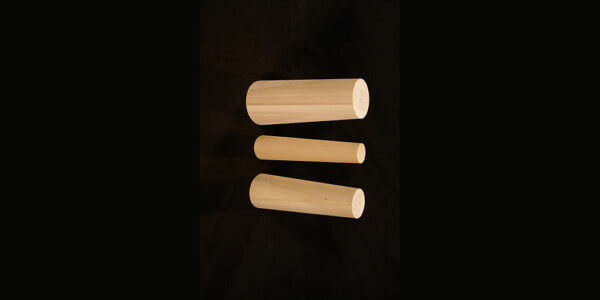Plastic Wood vs. Wood Filler: What’s the Difference
Need to patch some wood? Many people will opt for either plastic wood or wood filler to complete this job. But while both can fix damage, they’re not interchangeable. Neither is the best choice for every repair, especially for larger holes or when want the cleanest finish possible.
Truthfully, if you’re someone who values long-term performance (and not just patchwork fixes) you should think beyond filler. Serious repairs call for materials that can restore structure, not just hide flaws.
Let’s break down the differences between plastic wood and wood filler and why real wood plugs are often the better choice for serious repairs.
What Is Plastic Wood?
Plastic wood is a strong, solvent-based wood filler designed for heavier-duty repairs. It will usually contain wood fibers mixed with resins that cure to a very hard surface, almost like real wood. A well-known example of this is DAP Plastic Wood, which has been around for decades.
Because it’s solvent-based, plastic wood dries by evaporation. It sets up hard and fast. Once cured, it’s durable enough to be sanded, drilled, or painted. It also resists shrinking more than water-based fillers and can handle moderate amounts of exposure to moisture. This makes it a strong option for:
However, there are downsides. Plastic wood has a strong smell, cleanup requires mineral spirits, and it can dry out in the can if not sealed properly.
What Is Wood Filler?
Wood filler usually refers to water-based filler. It’s an easy-to-use option for small interior fixes with a paste-like texture, low odor, and cleans up with water. It’s great for filling nail holes, hairline cracks, and small gaps in trim, furniture, or cabinetry.
Water-based filler dries fast, but it isn’t as durable. It can shrink as it cures, especially in deeper holes, and it doesn’t hold up well outdoors. If it’s exposed to moisture over time, it may soften or fall out.
That being said, wood filler is a staple for indoor projects because it’s:

Applying Wood Filler for Trim and Furniture Repairs
Water-based wood filler being scooped with a putty knife. Ideal for nail holes, trim gaps, or cabinet touch-ups.
Key Differences Between Plastic Wood and Wood Filler
One of the main differences between plastic wood and traditional wood filler is their base materials. Plastic wood is solvent-based, so it uses chemical binders and resins that create a stronger, harder, and longer-lasting finish.
Wood filler is typically water-based. It’s easier to apply, more beginner-friendly, and far lower in fumes. Many consider it to be useful for indoor projects.
Plastic wood has the advantage in durability. It’s more water-resistant once it’s cured and holds up better without shrinking or cracking. Wood filler is easier to work with but more likely to shrink as it dries. This can lead to cracking or a patch that pulls away from the edges.
Each type of filler has its best-fit applications. Plastic wood is a better option for outdoor projects or for areas that will see more stress, such as door frames, stair treads, or exterior trim. Wood filler is better for interior repairs, like nail holes in trim, surface cracks in cabinetry, or minor gaps on furniture.
For cleanup, because plastic wood is solvent-based, you’ll need mineral spirits or another cleaning solvent to clean your tools and hands. Wood filler is water-based and can be cleaned up easily with soap and water.
It’s important to note that neither product will perfectly match natural wood grain, especially if you plan to stain the surface. However, plastic wood tends to take stain slightly better than water-based filler, since it often contains actual wood fibers. For a truly seamless look, especially on visible surfaces, neither filler can fully replicate the texture of real wood grain the way a wood plug can.
Why Neither Is Ideal for Large Holes
If your repair needs to last, this is where most filler-based solutions fall short. Need to patch a deep screw hole, a gouge, or any large void? If so, filler of any kind shouldn’t be your first option.
Even the strongest fillers have limitations. They can shrink, crack, or become brittle over time, and if you plan to stain your project, a blob of filler will always look different from the surrounding wood.
Structurally, filler also won’t grip a screw. So if you need to reattach hardware in the same spot, that filler repair is going to fail under pressure. A patch made from actual wood will always outperform a paste-based product.
Wood Plugs: A Better Fix for Bigger Holes
Instead of packing a hole with filler, smart woodworkers use wood plugs. A plug is a solid piece of wood (usually a dowel or round peg) cut to fit into a pre-drilled hole. Once glued in place and trimmed flush, it becomes part of the wood itself.
Below is how to install a wood plug.
- 1Clean and drill the hole to match your plug size.
- 2Apply wood glue to the hole or the plug.
- 3
Insert the plug. Align the grain if possible.
- 4Let the glue dry.
- 5Trim the plug flush with a flush-cut saw or chisel.
- 6Sand the surface smooth.
Wood plugs are preferred for structural and aesthetic reasons. They look better, hold up longer, and restore the strength of the wood better than any filler will be able to.

Custom Wood Spill Containment Plugs for Industrial and Emergency Use
Precision-turned wooden plugs used for sealing drains or containing liquid spills in industrial settings.
Benefits of Using Wood Plugs
- 1Strength and Structure: Plugs turn a weak or damaged area back into solid wood. You’ll be able to drill, screw, or refinish over a plug with full confidence.
- 2Clean Appearance: Using the same wood species for the plug allows it to blend nearly invisibly. Face-grain plugs give the most seamless finish for flat surfaces.
- 3Long-Term Durability: Unlike filler, plugs won’t shrink, pop out, or crack under stress. They expand and contract like the surrounding wood.
- 4Professional Look: Plugs are used in high-end furniture, staircases, and custom millwork to hide fasteners and create an uninterrupted surface.
Why We Recommend Wood Plugs at H.A. Stiles
We manufacture precision-cut wood plugs in bulk for builders, stair makers, furniture manufacturers, woodworking professionals, and more. They’re made from quality hardwoods and softwoods and cut to tight tolerances.
For professionals focused on durability and finish quality, plugs offer a level of structural integrity that paste-based solutions simply can’t replicate. Plugs are available in common and custom diameters, face grain or end grain, and oak, maple, cherry, poplar, pine, and many other species.
If you’re repairing a stair tread, covering lag screws in a post, or fixing a stripped hole in a cabinet door, for example, our plugs give you a finish that looks right and holds strong. We produce in high volumes, so you’ll always have consistent, ready-to-use stock on hand for your next job.
When to Use Each Option
Use water-based wood filler when:
Use plastic wood when:
Use wood plugs when:
Final Thoughts
Not every wood repair calls for the same approach. Fillers are great for minor blemishes, but when the goal is strength, longevity, and clean visuals, wood plugs win every time.
At H.A. Stiles, we help professionals make smart choices that benefit craftsmanship. Our wood plugs are the go-to solution for anyone serious about quality, appearance, and performance.
Need high-volume wood plugs for your next production run? We’re ready to quote. Contact us today and let’s get you what you need!
